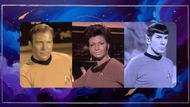Far beyond science fiction, technology predictions, and philosophical inquiries, Star Trek has had a far-reaching cultural impact. There were a lot of firsts with the 1966 debut of the first series. The episode "Plato's Stepchildren" (1968) was a watershed moment.
Most people agree that this episode included the first interracial kiss ever seen on American television.
When it happened, both praise and condemnation whirled about it. Many viewers viewed it as a positive development, while others, especially in the South, were outraged.
Despite everything, Star Trek: The Original Series was wildly popular with spectators. This momentous occasion served as a continual reminder of Star Trek's commitment to social justice and as proof that science fiction has the power to sway public opinion.
The prime directive of progress

As the civil rights movement gained momentum in the late 1960s, racial tensions in the US remained high. Due to institutional restraints, black actors and actresses in Hollywood often had to settle for small roles or overused clichés, and they rarely had opportunities for meaningful representation. Interracial romance? No way!
Particularly contentious were romantic relationships between actors and actresses of different races, which served to perpetuate the pervasive racism of the period. On the other hand, a different frequency was already at work on Star Trek, one that welcomed and celebrated variety.
Even though segregation laws were repealed, bigotry and prejudice were still entrenched in American society. During that period, television shows mainly mirrored these divisions; black actors rarely had key roles nor had intimate or romantic sequences with white actors.
When it came to diverse casting and daring narrative, Star Trek was already years ahead of its time. Star Trek was the canvas for the Federation to paint illustrations of a hopeful and brighter future.
The kiss that defied space-time conventions

In "Plato’s Stepchildren," an episode set in a world dominated by an advanced but cruel telekinetic society, Captain James T. Kirk (played by William Shatner) and Lieutenant Nyota Uhura (played by Nichelle Nichols) become the unwilling subjects of the Platonians’ sadistic amusement.
Inspired by ancient Greek aristocracy, the Platonians have remarkable mental abilities that they utilize to degrade and subjugate others for amusement. Among the most divisive and innovative events in television history, they drive Kirk and Uhura to kiss against their will as part of their psychological torture. Though the act itself had great weight, this might not have been a romantic kiss by intention.
It marked a milestone in challenging television norms, portraying an interracial kiss on a mainstream network show, which was practically unheard of at the time.
NBC executives, in a move straight out of the Terran Empire’s worst bureaucracy, were deeply concerned about potential backlash, particularly from Southern audiences. Their initial "solution"? Filming an alternate version where Uhura would kiss Spock instead, under the "logic" that "at least Spock wasn’t fully human." Racism, but make it sci-fi.
William Shatner and Nichelle Nichols, however, were not about to let history be rewritten. Shatner, ever the chaotic good of the Enterprise, outright sabotaged every attempt to shoot an alternate version without the kiss.
Nichols fully supported his approach. She first did as directed, but she soon saw the importance of the occasion and teamed with Shatner to make sure the kiss stayed. Later on, she remembered in her book that she thought the whole situation ridiculous, pointing out that Star Trek had already established as a shining example of inclusiveness. Why backtrack now?
For Nichols, the scene wasn’t just about rebellion against network executives. It was a stand for representation, a mission worthy of any Starfleet officer.
Shatner flubbed lines, crossed his eyes, and generally made a mess of any footage that didn't include the historic moment, forcing the network's hand. This was a deliberate and brilliant move from the actor to ensure that Star Trek lived up to its vision of an egalitarian future.
In her autobiography, Beyond Uhura: Star Trek and Other Memories, Nichelle Nichols recounts that during the filming of "Plato's Stepchildren," NBC executives were apprehensive about the audience's reaction to a kiss between a black woman and a white man. William Shatner was adamant about preserving the original scene.

Shatner, in a move that deserves a captain’s log of its own, intentionally sabotaged every alternate take where the kiss didn't happen. He crossed his eyes, messed up his lines, and made sure there was no usable footage without the kiss.
This is confirmed in the Blu-ray extras of the series, where Nichols herself recounts the events, making it clear that this wasn’t just an urban legend. It was a real battle for representation fought and won on the bridge of the USS Enterprise.

Prime directive: A cultural subspace signal
This kiss is often cited as a pioneering moment in television history, demonstrating that Star Trek was willing to challenge social norms and advocate for a future built on equality and unity.
Nichelle Nichols, who played Uhura, was already an influential figure for representation in the media. Her role as a black woman in a position of authority inspired figures such as Dr. Martin Luther King Jr., who famously encouraged her to remain on the show when she considered leaving.
Her presence and this specific moment helped open the path for more inclusive narratives in the following decades.
Nichols remembers getting a lot of great fan letters following the broadcast of the show. The answer was not, however, always favorable. Fearing a reaction from more conservative viewers, some Southern stations declined to broadcast the episode. Critics in several media sources also questioned if television was "ready" for such a strong racial commentary.
Despite the controversy, the vast majority of responses Nichols received were supportive, cementing the moment as a landmark in television history.
One letter from a white Southerner stated:
"I am totally opposed to the mixing of the races. However, any time a red-blooded American boy like Captain Kirk gets a beautiful dame in his arms that looks like Uhura, he ain't gonna fight it."
This response highlighted the significant impact of the scene during a time of prevalent racial prejudices.
Boldly 'kissing where no one has kissed before'
Following the famous lines by Captain James T. Kirk where he said,
"Space, the final frontier. These are the voyages of the starship Enterprise. Its 5-year mission: to explore strange new worlds, to seek out new life and new civilizations, to boldly go where no man has gone before.
Star Trek has continued to push for diversity and representation in all its iterations, making the franchise a symbol of progressivism in entertainment.
Looking back, the moment stands as a testament to television’s power to challenge social barriers and inspire change. In an era where discussions on representation continue to be relevant, Star Trek’s groundbreaking kiss remains an unforgettable part of television history.
